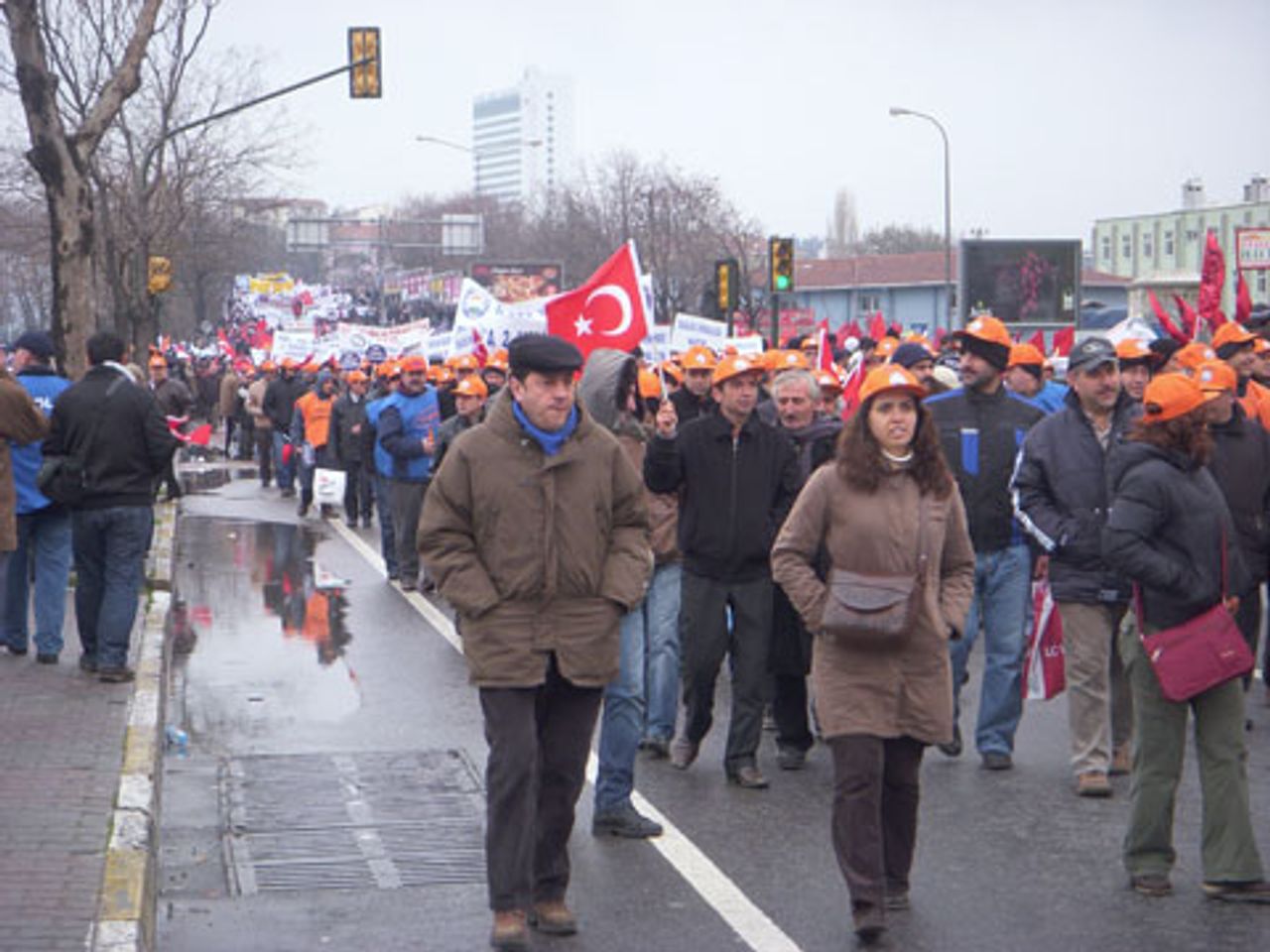 Anti-government protest in Istanbul February 15
Anti-government protest in Istanbul February 15Some 40,000 people demonstrated in Istanbul February 15 against the policies of the AKP (Justice and Development Party) government in the midst of the country’s enormous economic crisis.
The demonstration was jointly organised by the Confederation of Turkish Trade Unions (Turk-Is), the Confederation of Revolutionary Trade Unions of Turkey (DISK) and the Confederation of Public Workers Unions (KESK) under the slogan, “We Will Not Pay the Price of the Crisis: Labour and Democracy Rally for a Joint Fight against Unemployment and Poverty.”
Marchers carried banners declaring, “Collective bargaining is our right, the strike is our weapon,” “Price hikes, persecution, torture, here you are, the AKP,” “Factories are our strongholds, they can’t be closed down,” and “We will not pay for crisis.” Demonstrators chanted slogans such as: “Let the bosses pay for the crisis” and “Stop the labour thief AKP.”
A group of shipyard workers who have lost dozens of their fellow workers in accidents over the last number of years participated in the demonstration. They wore black aprons carrying the slogan, “No to workplace murders.”
Sintel Metal workers who have been picketing in front of their factory in Istanbul for the last two months, as well as striking workers from E-Kart, Burulas and DESA, were present at the protest and expressed their determination to continue their actions.
In the event, the participation of trade unionized workers on the February 15 march was relatively small, reflecting the continuing and rapid loss of membership in the Turkish unions that is threatening those organizations’ very survival.
In 1980, Turkey’s trade unions had a combined membership of more than 2 million out of a total population of about 45 million people. Today this figure hovers around 700,000 and the country’s population is now estimated to be 71 million. At a meagre 4.5 percent, Turkish union membership, as a percentage of the population, is one of the lowest in the world.
As a result of this loss in membership, Turkish unions in general, and Turk-Is and its affiliates in particular, are reaching a critical point where their ability to control the working class on behalf of the establishment is increasingly in doubt. For Turk-Is, the possibility of remaining a confederation based on the public sector, combined with friendly relations with the government and inevitably unprincipled manoeuvring, has already come to an end.
The primary reason for this development is the massive privatisation of public assets under the AKP government since 2002. The total funds arising from privatisation jumped from US$8 billion in the period 1985-2002 to US$41.9 billion in the period 2003-2008.
Previously the unions had steadily lost membership, but still had some room for manoeuvre, based on their relatively secure status in state-owned companies and institutions.
In the past, as the leadership of the country’s largest union confederation, the Turk-Is bureaucracy regularly organised two or three large, but mainly toothless, demonstrations (with attendance of around 100,000-200,000) between its congresses, held every four years. Turk-Is, was also very reluctant to collaborate with other union confederations and often angrily condemned left groups for “getting out of control.”
Turk-Is held its last demonstration of this kind almost five years ago in Ankara, the Turkish capital. Since then Turk-Is’ loss in membership has declined below a level making it possible for the union grouping to organise such events on its own. In response to the decline, the Turk-Is leadership has been striving to prove its usefulness to the government by turning the confederation into an undisguised and direct tool of the employers and state.
However, the ongoing and deepening economic crisis and dramatic increase in layoffs and wage cuts have made this strategy unsustainable. Jobless claim numbers in Turkey have been skyrocketing for the last few months, increasing 49 percent in October, 472 percent in December, 147 percent in November and 95 percent in January.
As economic growth plummets, the unemployment rate has started to rise rapidly. It reached 10.9 percent in the quarter ending in November, compared to 9.7 in the same period last year (Turkish economic statistics are issued on a three-month basis.) This figure has already passed the record set in 2001 when Turkey was rocked by a devastating crisis. In the first half of this year the official unemployment rate is expected to reach between 13 and 15 percent.
Under these conditions, in which the popular mood is becoming increasingly bitter and angry, the Turk-Is bureaucracy was forced to organise the joint February 15 demonstration to ensure it did not lose every shred of credibility.
Nevertheless, certain opportunist left groups in Turkey have been quick to declare that the latest protest represents a radicalisation of Turk-Is under the pressure of its rank and file members. These claims are aimed at boosting illusions in the bureaucratic apparatuses. Some of these organisations assert that there are class struggle unions within Turk-Is—and the “left” should ally itself with these organisations as the way forward.
This is very far from the truth. These “lefts” are attempting to rescue the union bureaucracies and paralyse workers at a time of immense crisis, when the political independence of the working class from the old organisations and perspective becomes the great question.
A number of the left groups were prominent on Sunday’s demonstration. However, instead of providing a socialist orientation to workers at a time of increasing popular discontent, most of these organisations merely chanted slogans while seeking to consolidate their members and supporters.
Official union speakers at the rally gave hollow speeches principally calling on the government to pay attention to the unions and take certain actions that would ease the impact of the economic crisis.
Such union rallies have long since been converted into platforms for the empty demagogy of this or that bureaucrat. The participants in the protest began dispersing shortly after the end of the demonstration. When the union officials finished their speeches they were surrounded by a small group of faithful supporters.
